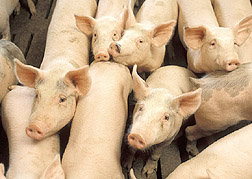This page has been archived and is being provided for reference purposes only. The page is no longer being updated, and therefore, links on the page may be invalid.
Read the magazine story to find out more. |
|
Swine Odor Researchers Target an Ill Wind
By Luis PonsAugust 3, 2006
Phenomena such as housing sprawl into farmland and the emergence of large-scale livestock operations have made odor from swine-production facilities a point of contention in many suburban and farming communities.
That's why the five researchers in the Agricultural Research Service (ARS) Swine Odor and Manure Management Research Unit at Ames, Iowa, are trying to tackle swine-manure odor at its source: inside the pig.
According to the unit's research leader, animal nutritionist Brian Kerr, the strategy at Ames is to formulate diets for the pigs that will lessen odor-causing compounds. His unit evaluates how factors such as nutrition, microbial ecology and pathogens affect how pigs excrete nutrients and produce odiferous waste.
One way the scientists have found to control nitrogen-containing compounds such as ammonia is to reduce the pigs’ protein intake by giving them less soybean meal and balancing their diet with crystalline amino acids. According to Kerr, research has shown that for each one percent reduction in dietary crude protein intake, ammonia emissions are reduced by eight to 10 percent.
The unit is also exploring how sulfur-containing odorants may be changed to lessen unpleasant smells from swine-production facilities.
Another tactic being examined is changing the type and amount of fiber being fed to pigs. Kerr explained that pigs don't digest all of their dietary fiber. Unit studies have found that metabolizing of this fiber leads to more production of volatile fatty acids that help keep ammonia from being released into the environment.
The unit’s efforts comprise one of numerous programs led by researchers with the ARS National Soil Tilth Laboratory in Ames that are aimed at making agriculture more environment-friendly. Carbon storage in soil, management strategies for soil and water, and the quality of air around agricultural operations are among the many environmental issues being addressed there.
Read more about this research and other ARS projects related to a healthy environment in the August 2006 issue of Agricultural Research magazine.
ARS is the U.S. Department of Agriculture's chief scientific research agency.


